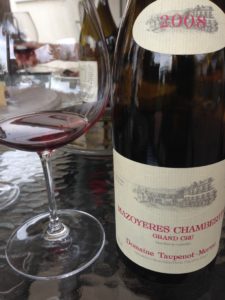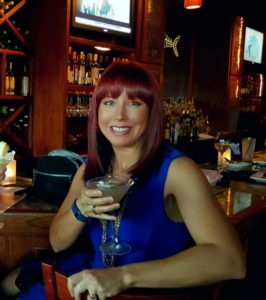We decided to take last week’s Chardonnay episode up a notch and roll it into a little primer on Burgundy!
In our glasses:
Steph: 2014 Zudugarai Getariako Txakolina (only 10.5% abv). This bottle was reviewed by Wine Enthusiast Magazine earlier this year. Let’s all say the grape’s name – Hondarrabi Zuri. What a happy name!
Val: Campredon by Domaine Alain Chabanon. This is a 2013 from Languedoc, it’s certified biodynamic, hand harvested GSM. This is black fruit, juicy, jammy, violets and going down really easy.
Discussion Topic: Burgundy Basics
Actually it’s called Bourgogne. Not sure why, but this is the only wine region in France that was translated to suit the English-speaking people of the wine world. Think about it: Bourdeaux, Alsace, Loire, Languedoc-Roussillon – I would think that last one is harder to say that Bourgogne. Either way, it’s a wine region in northeastern France that can trace its viticultural roots back to before the Romans. It’s called Bourgogne because the Germanic tribes called the “Burgondes” named their new kingdom after themselves, hence Burgundia. This would have been around the mid-late 5th century.
On a map: There are five official regions within Bourgogne. Furthest north is the Chablis region and the Chatillonais & Grand Auxerrois; the Cote d’Or begins around Dijon and this is further divided into the Cote de Nuits, which extends south to Corgoloin, and the Cote de Beaune which extends to Les Maranges. As we head further south along the A6 toward Lyon we have the The Cote Chalonnais (which we don’t hear about a lot), which likes east of Chalon Sur Saone, and, finally the Maconnais, north of Beaujolais.
There’s a lot going on in this region, so it’s important to remember this: Pinot Noir & Chardonnay. That’s not all there is, but generally that’s mostly what you’ll see in the stores. The bottle shapes also tend to be different in that they have rounded, feminine (if you will) shapes as opposed to the more squared shoulders of the Bordeaux style bottles.
Styles? Well, we talked about Chablis briefly last week, but generally these will have much more acidity and take longer to mature in bottle. As for the wines from the regions further south, not as much new oak is used so I mentioned last week that the wines would be more balanced, less oaky but still with a structure and softness. Again, we have to defer to the winemaker or producer and their choices. Fine Burgundies are known for gentle nuances, delicacy, complexity and the ability to age. Some are more fruit-forward and easy to drink now, and some will be better off after 3-4 years – or more – in bottle.
FACTOID:
Burgundy fun facts – going to geek out a little here:
It has the most appellations or AOCs in France, 20%. Ironically it has 1/5th the land holdings of Bordeaux, yet is the 4th largest in production.
Red wines: Mostly Pinot Noir, yet, some wines can have Gamay, (remember the main grape in Beaujolais?) such as Passe-tout-Grains AOC. Passe-tout-Grains, if you can find it for the #W25Challenge, is mostly Gamay, but must contain at least 33% Pinot Noir and/or something called Pinot Liebault. Also in the red or rose’ wine can be a maximum of 15% Pinot Blanc, Pinot Gris and/or Chardonnay!
There is also Bourgogne Gamay – which is at least 85% Gamay!
White wines: Mostly Chardonnay, but Bourgogne Aligote’ AOC and Bouzeron are made with the Aligote’ grape.
Interestingly enough … Bourgogne produces more white wine than red!
Another geeky little tidbit: There’s a Sauvignon Blanc appellation called Saint Bris (since 2003). This is south of Chablis.
There is also a quality pyramid, as many regions have:
Grands Crus are at the top and most specific in location (single vineyard) – and most expensive.
 Premier Crus, further down the pyramid, are also site specific and can include village name. Certain villages are designated as Premier Cru villages, so if you just see the village name but no vineyard name? This means that the wine has been made with grapes from several Premier Cru Vineyards. It’s OK, there are over 63 of these, and no – we don’t have them memorized.
Premier Crus, further down the pyramid, are also site specific and can include village name. Certain villages are designated as Premier Cru villages, so if you just see the village name but no vineyard name? This means that the wine has been made with grapes from several Premier Cru Vineyards. It’s OK, there are over 63 of these, and no – we don’t have them memorized.
Mostly what we see – and drink, as in, can afford – are Village level or Regional wines. You may have seen Rully or Macon. Village wines account for just over 36% of all production. Regional wines, such as Bourgogne AOC generally have Bourgogne in the name, are more than half of the wines produced here.
Those grands crus & premier crus we mentioned earlier? About 2 and 10%, respectively, of wines produced in Bourgogne. And speaking of … guess where you’ll be able to taste some of these? The Boulder Burgundy Festival! October 20-23. The ‘Old and Rare” Burgundy Seminar on Friday Oct 21 looks extraordinary! You will taste unicorn wines. Jay Fletcher, MS said , “You really can’t put a price on some of these wines. They are so hard to come by.” Now that’s what I like to hear! Probably a lot of wine porn at that seminar.
For further reading and gorgeous photography (by Andy Katz) to boot, Val recommends this book by Nicholas Faith, Burgundy and Its Wines, to embark on your journey of this fascinating wine region. It’s not too hard or geeky to read, but is a helpful guide to the sub-regions, wines, styles and producers. We also like the Official Bourgogne Wines Site.
- #W25Challenge Winner
The 3rd quarter #W25Challenge winner is Michelle Miller from Reno! Congrats Michelle! This was for the 12 September Facebook post about Passito di Pantelleria, a dessert wine from the Sicilian island of Pantelleria! Cheers, Michelle!
- Patreon Love
Jeff E from the hilarious drinking show, We Like Drinking
You may remember this guy from Episode 35: We Like Drinking With a Free Lunch. Jeff and the boys can be found every Friday morning in your downloads if you subscribe to their show. Jeff is a fellow wine lover and a Certified Specialist of Wine (CSW) through the Society of Wine Educators, so he’s part of our tribe. Much Patreon love to you, Jeff, our “Drinking Podcast Brother From Another Mother!”
“It’s not five o’clock and we don’t care” listeners. You want your podcast when you want it, and your wine when you want it. Nobody’s going to tell you when it’s time to pull that cork. Thank you:
We love you Meg from South Dakota!
Thank you Clay from Arizona!
Our new patron this week is Jon from California!
Please share Wine Two Five with your friends and online community, and we certainly appreciate all your involvement and feedback. Leave us a burning wine question or comment and you could hear it on the show! We’d also love it if you’d go out to iTunes and show us some love there in the form of a glowing iTunes review so other wine lovers can discover our fun W25 community. We also can be found on our FB page, Twitter, Pinterest & YouTube, Google +. Also, if you want to build your collection of wine books or accessories – like GoVino – please check out the online store also located on our website!
Connect with Val on Twitter @WineGalUnboxed and on the Vino With Val FB page, and on instagram as Vino with Val.
You can find Steph on Twitter @Albarellosoap and on the AlbarelloSoap FB page, and check out the videos on the Albarello YouTube channel! One more thing… Don’t forget to use the #W25Challenge when you are trying new wines and drinks. Until next week …. Cheers!
